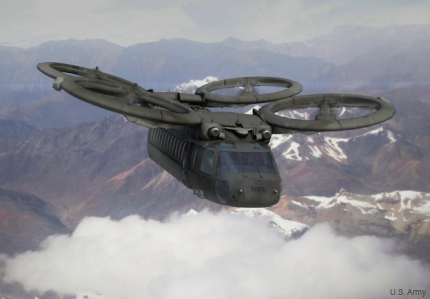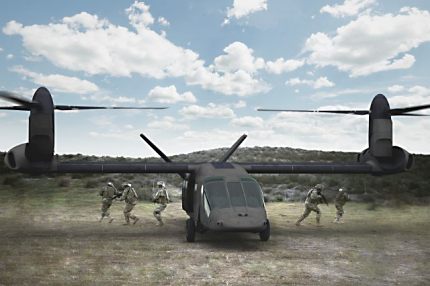What future Army aircraft could look like
Army research teams are collaborating with each other and industry on the next generation of vertical-lift aircraft.

An artist’s concept of a future Army vertical lift rotorcraft.
Army researchers are working on the next generation of military vertical-lift aircraft with an effort that involves the collaboration of the service’s research centers and laboratories, design and manufacturing work from industry, and support from NASA and the Navy.
The idea is to draw on the expertise from around the Army’s science and technology community to build a new fleet of aircraft that can take off, hover and land like a helicopter, fly like a plane, and be used by joint forces.
"The one thing that we've not done in quite a long time was demonstrate that we can build an aircraft from scratch that incorporates the individual technologies that we've been working on the past 25 years," Ned Chase, deputy program director of S&T for the Joint Multi-Role Technology Demonstrator/Future Vertical Lift, said in a release. "We have the capacity across AMRDEC to populate the aircraft with the right components--engines, rotors, structures, flight controls.

Bell Helicopter's design for the tiltrotor V-280 Valor aircraft.
AMRDEC is the Aviation and Missile Research, Development and Engineering Center, one of seven centers and labs that make up the Army’s Research, Development and Engineering Command. While AMRDEC, where Chase works, will focus on aviation, scientists at other centers will contribute their expertise. The Communications-Electronics Research, Development and Engineering Center, for example, can perform work in communications systems, sensors and cameras.
The Future Vertical Life, or FVL, program is expected to culminate in two main demonstrations. One, the Air Vehicle Demonstration, will be carried out with two contractor teams, Sikorsky/Boeing and Bell Helicopter, which will handle the design, analysis, fabrication, ground testing and flight testing of the demonstrator aircraft.
The aircraft, according to industry proposals, will be able to carry and crew of four plus 12 troops, hover at up to 6,000 feet (at 95 degrees Fahrenheit) and travel at a speed of at least 230 knots for 2,100 nautical miles. The first flight testing is expected in summer 2017, with a prototype expected between 2022 and 2024.

Sikorsky and Boeing are working on a demonstrator called the SB-1 Defiant.
The other demonstration, the Mission Systems Architecture Demonstration, intends to integrate technologies from across the Army’s research centers into a standard reference architecture that will serve as the foundation for an avionics architecture for a joint fleet, which researchers noted would save money over developing separate aircraft for each service.
Although many of the technologies exist, they need to be honed to perform in what researchers said will be a tougher environment than those technologies operate in now. "This future fleet will be faster and go farther,” Chase said. “We're trying to ensure that the other [research centers] understand how the aviation environment and constraints change when we go from flying aircraft at 130 knots to 250 knots. The environment we're creating for weapons, sensors and radios is much different with FVL than the current fleet. FVL will operate in a different performance regime."
The Defense Advanced Research Projects Agency also is working on similar technology—for both manned and unmanned aircraft—with itsVTOL Experimental Plane project. Both Boeing and Sikorsky, along with two other companies, are also involved in that project.
NEXT STORY: DISA CIO targets cloud automation